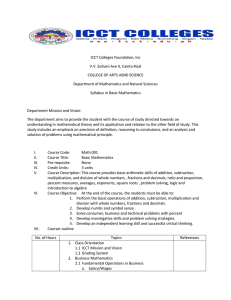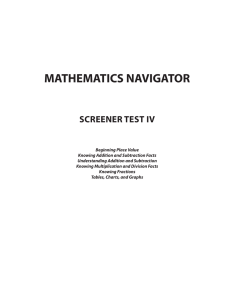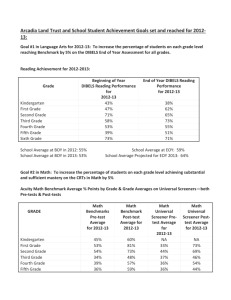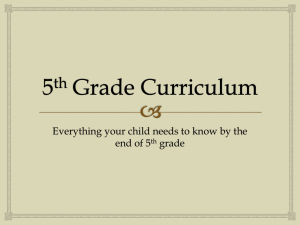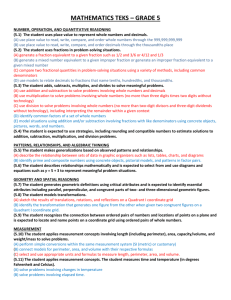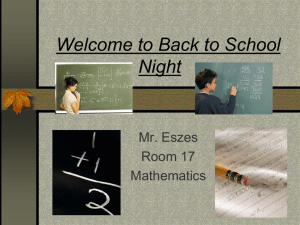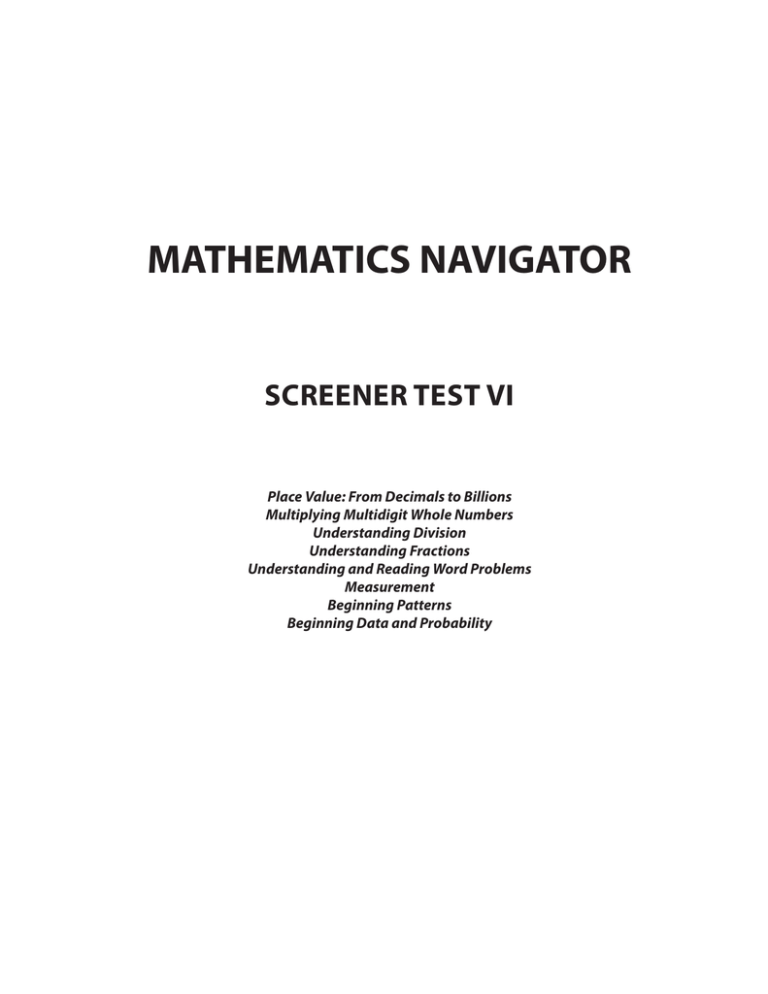
MATHEMATICS NAVIGATOR
Screener Test VI
Place Value: From Decimals to Billions
Multiplying Multidigit Whole Numbers
Understanding Division
Understanding Fractions
Understanding and Reading Word Problems
Measurement
Beginning Patterns
Beginning Data and Probability
This Screener Test has been designed to correlate with the NCTM Curriculum Focal Points.
Each Screener Test focuses on three to eight Mathematics Navigator modules, which in turn
focus on addressing misconceptions students may have about mathematics concepts.
Screener Test VI is designed to be given at the beginning of the school year. It covers the
standards that students need in order to be successful at their grade level.
The results of this Screener Test will help instructors identify gaps in students’ knowledge and
determine which Mathematics Navigator modules will help fill those gaps. Participation in
these modules will help students succeed in mathematics and on their state assessments tests.
America’s Choice® is a subsidiary of the National Center on Education and the Economy® (NCEE), a Washington, DC-based
non-profit organization and a leader in standards-based reform. In the late 1990s, NCEE launched the America’s Choice School
Design, a comprehensive, standards-based, school-improvement program that serves students through partnerships with states,
school districts, and schools nationwide. In addition to the school design, America’s Choice provides instructional systems in
literacy, mathematics, and school leadership. Consulting services are available to help school leaders build strategies for raising
student performance on a large scale.
© 2009 by America’s Choice
All rights reserved. No part of this publication may be reproduced or transmitted in any form or by any means, electronic or
mechanical, including photocopy, recording, or any information storage and retrieval system without permission from the
America’s Choice permissions department.
America’s Choice and the America’s Choice logo are registered trademarks of America’s Choice. The National Center on
Education and the Economy is a registered trademark of The National Center on Education and the Economy.
First Printing 2009
1 2 3 4 5 6 7 8 9 10 12 11 10 09 08
ISBN 978-1-60637-604-1
http://www.americaschoice.org
e-mail: products@americaschoice.org
Screener Test VI
1. Which representation is not equal to 535.270?
A.
500 + 30 + 5 + 0.2 + 0.07
B.
535
C.
D.
270
1, 000
Hundreds
Tens
Ones
Tenths
Hundredths Thousandths
Five hundred thirty-five two hundred seventy
–––––––––––––––––––––––––––––––––––––––––––––––––––––––––––––––––––––––––––––––––––––
2. If you start with $65.49 and spend $3.67, how much money do you have left?
A.
$31.39
B.
$62.22
C.
$69.16
D.
$61.82
–––––––––––––––––––––––––––––––––––––––––––––––––––––––––––––––––––––––––––––––––––––
3. Isabel traveled 62,483 miles in her car in four years and Leo traveled 58,575 miles in his
car in four years.
How much farther did Isabel travel than Leo in four years?
A.
16,112 miles
B.
121,058 miles
C.
3,908 miles
D.
4,112 miles
➥
GO ON
©America’s Choice
Mathematics Navigator
|
Screener Test VI
4. The number 127,884 rounded to the
nearest ten thousand is:
7. Which expression could be used to
solve this equation?
832 × 480 = n
A.
130,884
B.
128,884
A.
(800 × 480) + 32
C.
128,000
B.
(800 × 480) + (32 × 480)
D.
130,000
C.
(832 × 12) + (832 × 40)
D.
(104 × 480) + (8 × 480)
–––––––––––––––––––––––––––––––––––––––––
5. What does the digit 9 stand for in the
number 5.709?
A.
Nine ones
B.
Thousands
C.
Thousandths
D.
Nine thousandths
–––––––––––––––––––––––––––––––––––––––––
6. Which equation uses the commutative
property of multiplication?
A.
630 × 125
= (630 × 100) + (630 × 25)
B.
630 × 125
= (7 × 9 × 5 × 2) × (5 × 5 × 5)
C.
630 × 1 = 630
D.
630 × 125 = 125 × 630
–––––––––––––––––––––––––––––––––––––––––
8. Mrs. Chi’s new car gets between 22
and 27 miles per gallon of gasoline.
Last week she used 10 gallons
of gasoline.
Which number is the best estimate of
how many miles she traveled in her
car last week?
A.
49
B.
250
C.
490
D.
2,400
➥
GO ON
|
Screener Test VI
©America’s Choice
Screener Test VI
9. A truck company bought 402 new tires
at a cost of $235 per tire. How much
did the truck company spend?
A.
$9,870
B.
$4,020
C.
$94,470
D.
$94,000
–––––––––––––––––––––––––––––––––––––––––
10. The parking lot at the mall is full! All
35 rows of parking spots are filled.
Each row has 24 cars. How many cars
are parked in the parking lot?
A.
840 cars
B.
210 cars
C.
940 cars
D.
80 cars
11. Three girls shared these
stickers equally.
How many stickers did each girl get?
A.
3
B.
4
C.
5
D.
15
–––––––––––––––––––––––––––––––––––––––––
12. If you know that 1,173 = 23 × 51, then
which equation is true?
A.
51 ÷ 1,173 = 23
B.
23 = 1,173 × 51
C.
51 = 1,173 ÷ 23
D.
23 ÷ 1,173 = 51
➥
GO ON
©America’s Choice
Mathematics Navigator
|
Screener Test VI
13. Mr. Samson has 80 chairs and puts
them into 5 equal rows.
16. Which equation describes the
shaded area?
Which operation shows how you can
find the number of chairs in each row?
A.
Divide 5 by 80
B.
Add 5 to 80
C.
Multiply 80 and 5
D.
Divide 80 by 5
–––––––––––––––––––––––––––––––––––––––––
14. Malaya has 56 pennies in bags. Each
bag contains 7 pennies.
How many bags does Malaya have?
A.
8 bags
B.
9 bags
C.
49 bags
D.
63 bags
–––––––––––––––––––––––––––––––––––––––––
15. Estimate the answer to this problem:
The cafeteria is preparing 160
hamburgers for the school picnic.
Each hamburger must be served in
a bun.
If hamburger buns come in packages
of 8, how many packages must the
cafeteria buy?
A.
About 1,600 packages
B.
About 20 packages
C.
About 170 packages
D.
About 160 packages
A.
75
= 75
100
B.
75
= 75.100
100
C.
3
= 0.60
5
D.
3
= 0.75
4
–––––––––––––––––––––––––––––––––––––––––
17. Which of these fractions is closest in
value to 0.47?
A.
1
50
B.
1
4
C.
1
3
D.
1
2
➥
GO ON
|
Screener Test VI
©America’s Choice
Screener Test VI
18. Which point on the number line best represents
5
?
4
A.
0
1
2
3
4
5
6
0
1
2
3
4
5
6
0
1
2
3
4
5
6
0
1
2
3
4
5
6
B.
C.
D.
–––––––––––––––––––––––––––––––––––––––––––––––––––––––––––––––––––––––––––––––––––––
19. Which numbers are all closer to 0 than to 1?
A.
1
5
, 0.002,
8
6
B.
1.032,
C.
3
86
, 0.132,
20
1000
D.
0.123, 1.023,
1 3
,
2 8
1
50
➥
GO ON
©America’s Choice
Mathematics Navigator
|
Screener Test VI
20. The number 1.4 is the same as:
A.
1
4
B.
1
4
10
C.
1
1
4
D.
8
5
22. Amir wants to swim 200 laps at swim
practice today. He decides to practice
his backstroke for 15 minutes and
then switch to freestyle. When he
does the backstroke, he swims 5 laps
per minute.
How many laps will he need to swim
freestyle to reach his goal of 200 laps?
A.
125 laps
B.
195 laps
C.
75 laps
D.
135 laps
–––––––––––––––––––––––––––––––––––––––––
1
cups of orange juice
2
1
concentrate with 4 cups of water to
2
make orange juice. Which equation
will help her find the number of cups
of juice she will have once it is mixed?
21. Malaya mixes 1
A.
1
1
4 –1 =3
2
2
B.
1
C.
1
1
4 ÷1 =3
2
2
D.
4
1
1
+4 =6
2
2
–––––––––––––––––––––––––––––––––––––––––
23. Mr. Samson’s car can go 27 miles on a
gallon of gas. Last week he drove 108
miles to visit his sister.
How much gas did he use on the trip?
A.
135 gallons
B.
81 gallons
C.
3 gallons
D.
4 gallons
1
1
3
×1 =6
2
2
4
➥
GO ON
|
Screener Test VI
©America’s Choice
Screener Test VI
24. Miguel has a new roll of packaging
tape that contains 25 yards of tape.
He uses 7 feet to tape a box together to
mail to his sister. Then he uses 2 feet
more to seal a box for his mother.
How much tape is left on the roll?
26. If you were to measure the length of
your classroom, the best unit to use
would be:
A.
ft2
B.
miles
A.
22 yards
C.
km2
B.
16 yards
D.
feet
C.
34 yards
D.
28 yards
–––––––––––––––––––––––––––––––––––––––––
25. Malaya earns $50 a day. She worked
three days last week and four days
this week.
Which expression shows how much
Malaya earned for those two weeks?
A.
50 + 50
B.
3 + 4 • 50
C.
(3 • 50) + (4 • 50)
D.
(3 + 4) + 50
–––––––––––––––––––––––––––––––––––––––––
27. If the length of a rectangular pool is 15
meters and its perimeter is 40 meters,
what is the width of the pool?
A.
25 meters
B.
5 meters
C.
375 square meters
D.
600 square meters
–––––––––––––––––––––––––––––––––––––––––
28. If the length of a rectangular lawn is 12
meters and its area is 60 square meters,
which expression could be used to find
the width of the lawn?
A.
60 – (12 × 2)
B.
60 ÷ 12
C.
60 + 12
D.
60 × 12
➥
GO ON
©America’s Choice
Mathematics Navigator
|
Screener Test VI
29. The apple tree is 6' 8" tall and the pear
tree is 68" tall. Which tree is taller and
by how much?
A.
The pear tree is 8 inches taller.
B.
The trees are the same height.
C.
The apple tree is 10
inches taller.
D.
The apple tree is 1 foot taller.
–––––––––––––––––––––––––––––––––––––––––
30. What is the area of this figure?
31. Which pattern follows this rule?
Start with 2 and multiply by 3.
A.
2, 5, 8, 11, 14, 17, …
B.
2, 6, 12, 24, 48, 96, …
C.
2, 6, 18, 54, 162, …
D.
2, 6, 9, 12, 15, …
–––––––––––––––––––––––––––––––––––––––––
32. If school ends in exactly 4 weeks,
how many days are left until the end
of school?
You can use the table below to
help you.
3 cm
2 cm
1 cm
4 cm
Number
of Weeks
Number
of Days
1
7
2
14
3 cm
3
4
1 cm
5
1 cm
A.
12 cm2
B.
11 cm2
C.
15 cm2
D.
16 cm2
6
A.
20
B.
7
C.
4
D.
28
42
➥
GO ON
|
Screener Test VI
©America’s Choice
Screener Test VI
33. Josh made this pattern of figures
with tiles.
35. Which set of numbers could be used to
continue this pattern?
90, 88, 84, 78, ____ , _____ , ____
If this pattern continues to grow in the
same way, how many tiles will be in
the next figure?
A.
All of these
B.
9
C.
5
D.
1
A.
84, 78, 84
B.
76, 74, 72
C.
72, 66, 60
D.
70, 60, 48
–––––––––––––––––––––––––––––––––––––––––
36. Which event is most likely to occur
when you spin this spinner once?
–––––––––––––––––––––––––––––––––––––––––
34. Tamika wrote the number
pattern below.
100, 93, 86, 79, 72, 65, ____
If the pattern continues to decrease as
shown, which rule can be used to find
the next number in the pattern?
A.
You will spin gray.
B.
You will spin white.
A.
Add 7
C.
You will spin black.
B.
Subtract 7
D.
All events are equally likely.
C.
Multiply by 7
D.
Divide by 7
➥
GO ON
©America’s Choice
Mathematics Navigator
|
Screener Test VI
A.
4
B.
1
3
C.
4
8
D.
1
4
39. Look at the graph below. If the
number of bicycle accidents in which
the rider wasn’t wearing a helmet in
1980 was 300, what was the number of
such accidents in 1990?
Number of Bike Accidents
Without a Helmet
Number of Accidents
37. You have 4 green marbles, 2 red
marbles, and 2 yellow marbles in
a bag. If you draw 1 marble out of
the bag at random, what is the
probability that the marble you
draw will be green?
0
1980
1990
2000
Year
–––––––––––––––––––––––––––––––––––––––––
38. Look at the graph below. If the
number of tornados sighted in 1985
was 600, what was the number of
tornados sighted in 2005?
Number of Tornados
Number of Tornados Sighted
A.
4
B.
300
C.
400
D.
350
–––––––––––––––––––––––––––––––––––––––––
40. Gabby rolled a regular
6-sided die 4 times and
got “3” every time. When
she rolls it the next time,
what is the probability that
she will get “3” again?
1980
1985
1990
1995
2000
2005
Year
10
|
A.
5
B.
1,000
C.
10
D.
800
Screener Test VI
A.
5
6
B.
100% chance
C.
1
6
D.
0% chance
STOP!
©America’s Choice
Screener Test VI Answer Key
Question Answer
Number
Key
Content Description
Unit
1
D
Represents decimals in different equivalent forms,
including words, expanded form, mixed numbers,
and tables
2
D
Develops facility with addition and subtraction of
decimals in the context of a word problem
3
C
Develops facility with addition and subtraction of
five-digit numbers in the context of a word problem
4
D
Extends an understanding of place value to numbers
up to 100,000 by rounding six-digit numbers to the
nearest ten thousand
5
D
Extends an understanding of place value to decimal
numbers up to the thousandths by identifying the
value of a digit in a decimal
6
D
Demonstrates an understanding of the commutative,
distributive, and associative properties of
multiplication
7
B
Applies an understanding of the properties of
operations to analyze strategies for multiplying
three-digit whole numbers
8
B
Selects appropriate methods to estimate the solution
to a word problem involving multiplication of
two-digit numbers
9
C
Develops fluency with efficient procedures for
multiplying three-digit whole numbers in the context
of a word problem
10
A
Develops fluency with efficient procedures for
multiplying two-digit whole numbers in the context
of a word problem
©America’s Choice
Place Value:
From Decimals
to Billions
Multiplying
Multidigit
Whole
Numbers
Mathematics Navigator
|
11
Screener Test VI Answer Key
Question Answer
Number
Key
Content Description
C
Applies an understanding of division and uses known
division facts to solve a problem in which a group of
objects is shared equally.
12
C
Applies an understanding of the inverse relationship
between division and multiplication to identify
equivalent expressions
13
D
Selects appropriate methods and applies an
understanding of division to identify the division
process that can be used to solve a word problem
14
A
Selects appropriate methods and uses known division
facts to solve a word problem
15
B
Applies an understanding of division and uses
known division facts to estimate the solution to a
word problem
16
D
Connects equivalent fractions and decimals using
a model
D
Develops an understanding of the connections
between fractions (halves, thirds, fourths, fifths) and
decimals by identifying the fraction that is closest to a
given decimal
B
Develops an understanding of the connections
between fractions (halves, thirds, fourths, fifths,
and tenths) and decimals by locating a fraction on a
number line
C
Develops an understanding of the connections
between fractions and decimals by comparing and
ordering decimals and fractions, using benchmark
numbers such as 0, 1/2, and 1
B
Develops an understanding of the connections
between fractions (halves, fourths, fifths, and
tenths, including mixed numbers) and decimals by
identifying the fraction or mixed number that is equal
to a given decimal
11
17
18
19
20
12
|
Screener Test VI
Unit
Understanding
Division
Understanding
Fractions
©America’s Choice
Screener Test VI Answer Key
Question Answer
Number
Key
Content Description
Unit
21
B
Uses equations, models, and relationships to solve
word problems
22
A
Uses equations, models, and relationships to solve
multistep word problems involving ratio and rate
23
D
Uses simple reasoning about multiplication and
division to solve one-step word problems involving
ratio and rate
24
A
Uses equations, models, and relationships to solve
multistep word problems
25
C
Uses simple reasoning about multiplication and
addition to write an expression that could be used to
solve a multistep word problem involving rate
26
D
Uses an understanding linear measure and units of
measure to determine the correct unit
27
B
Uses knowledge of perimeter to solve a problem
28
B
Develops an understanding of area by selecting the
expression that represents the area in a word problem
29
D
Computes the difference between the height of two
objects by converting accurately from one unit of
measure to another
30
B
Selects appropriate units of measure and strategies
(e.g., decomposing shapes) to calculate the area of a
nonstandard figure
31
C
Finds a numeric pattern involving multiplication that
follows a given rule represented in words
32
D
Identifies numeric patterns involving multiplication
with the aid of a table and applies an understanding
of patterns to solve a word problem
33
B
Identifies numeric patterns and their rules in order to
extend a pattern represented by a model
34
B
Identifies numeric patterns and their rules in order to
extend a pattern
35
D
Identifies numeric patterns and their rules in order to
extend a pattern
©America’s Choice
Understanding
and Reading
Word Problems
Measurement
Beginning
Patterns
Mathematics Navigator
|
13
Screener Test VI Answer Key
Question Answer
Number
Key
Content Description
B
Uses theoretical probability and proportions to
predict the outcome of an event
37
C
Demonstrates an understanding of the concept that
when all outcomes of an experiment are equally likely,
the theoretical probability of an event is the fraction of
outcomes in which the event occurs
38
B
Analyzes and interprets line graphs to answer
questions about a situation
39
C
Analyzes and interprets bar graphs to answer
questions about a situation
C
Demonstrates an understanding of the concept that
when all outcomes of an experiment are equally likely,
the theoretical probability of an event is the fraction of
outcomes in which the event occurs
36
40
14
|
Screener Test VI
Unit
Beginning Data
and Probability
©America’s Choice



